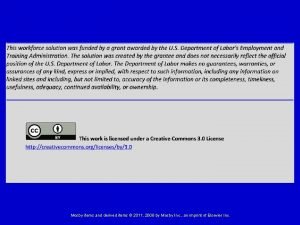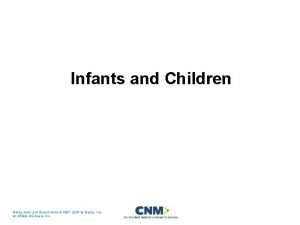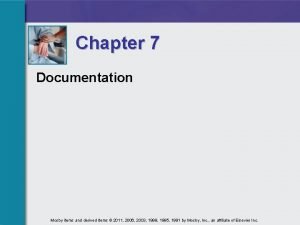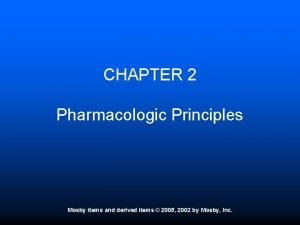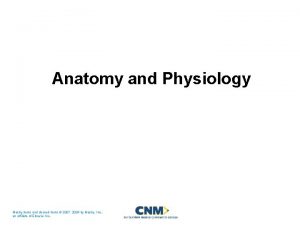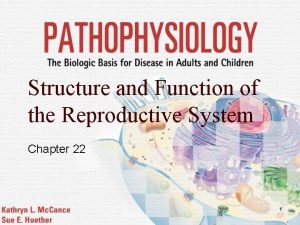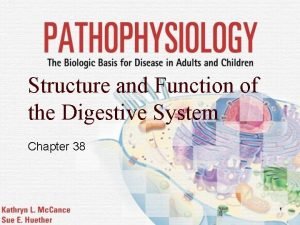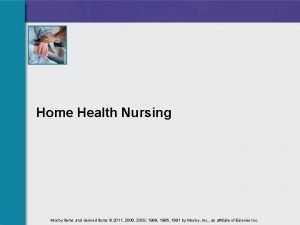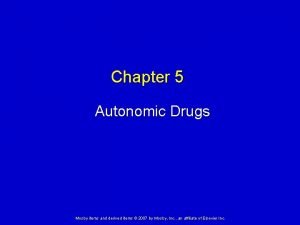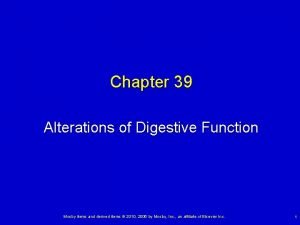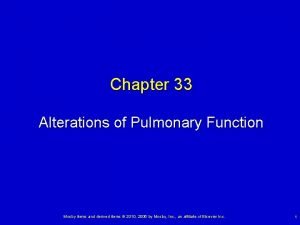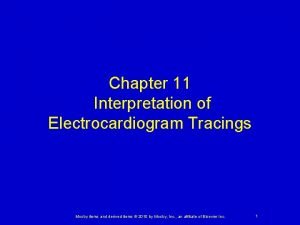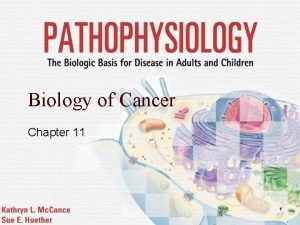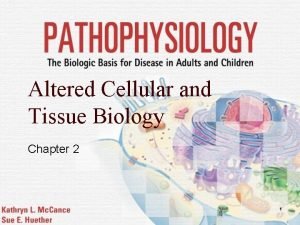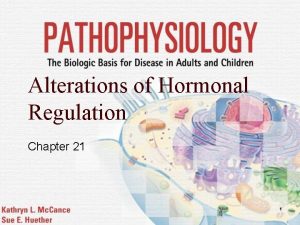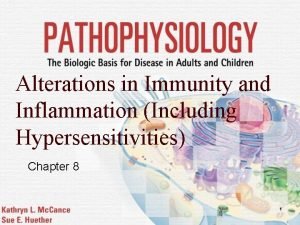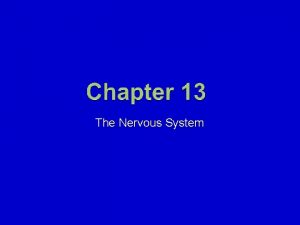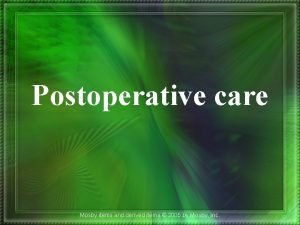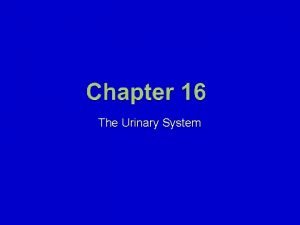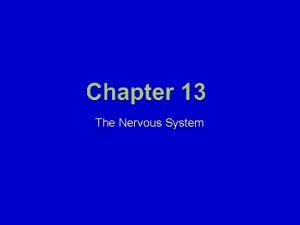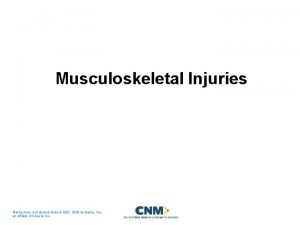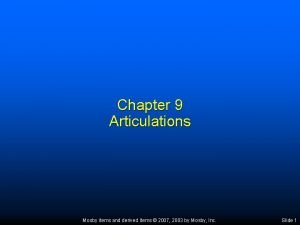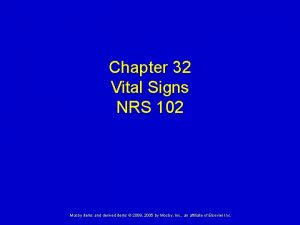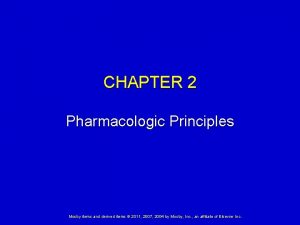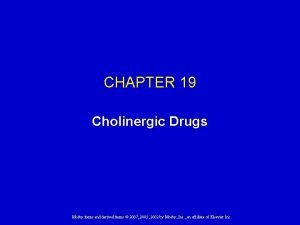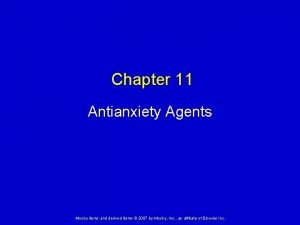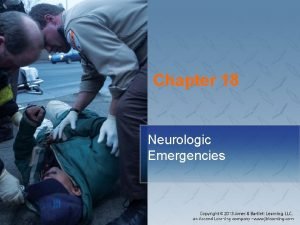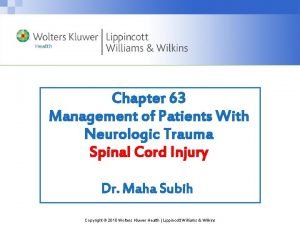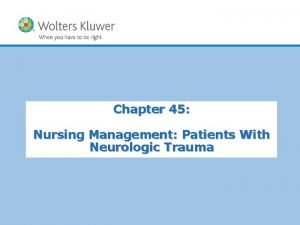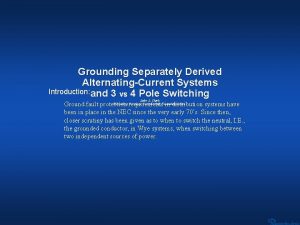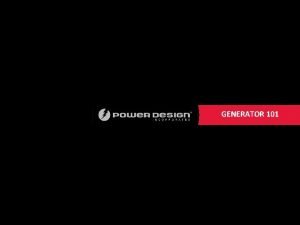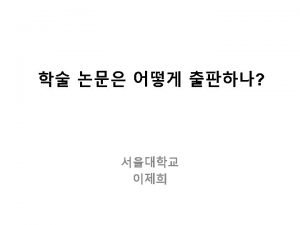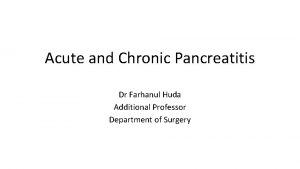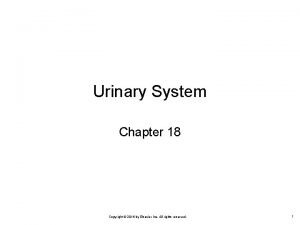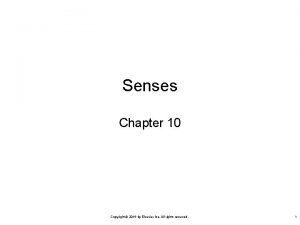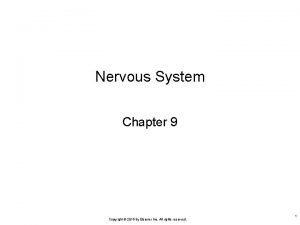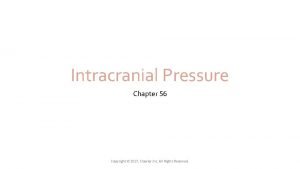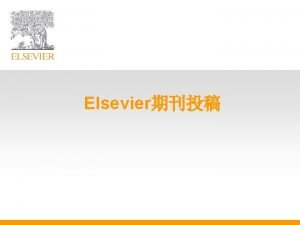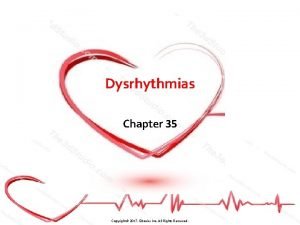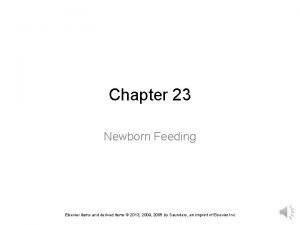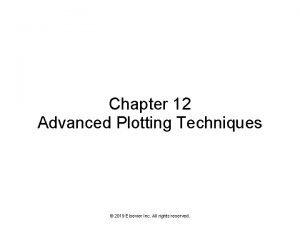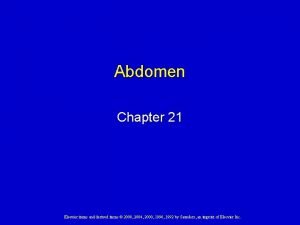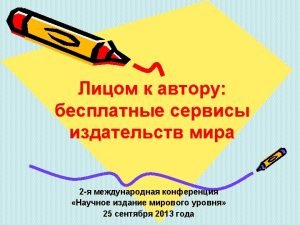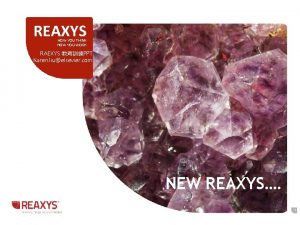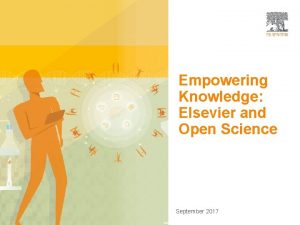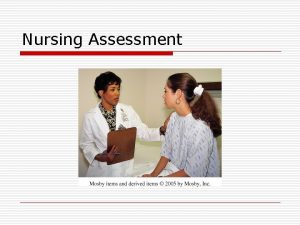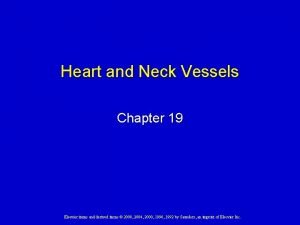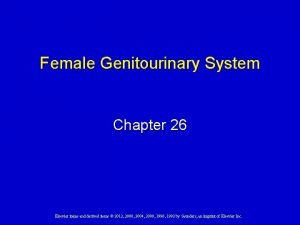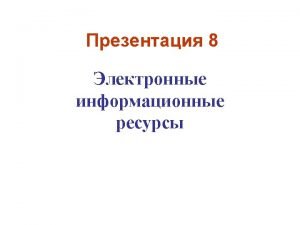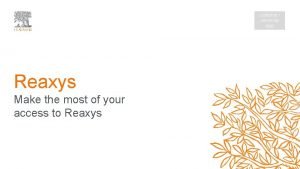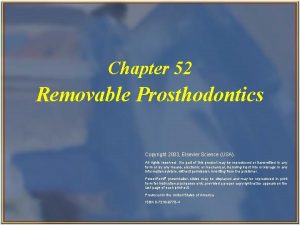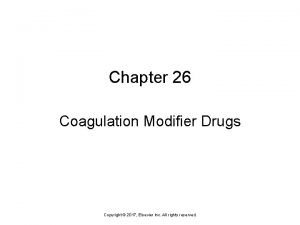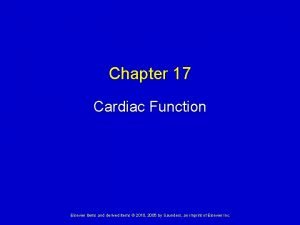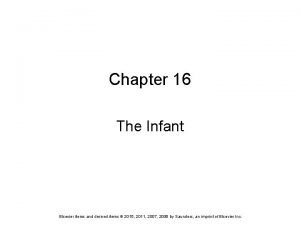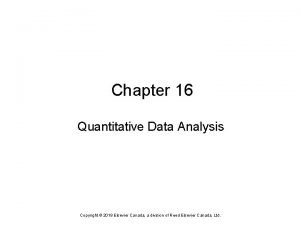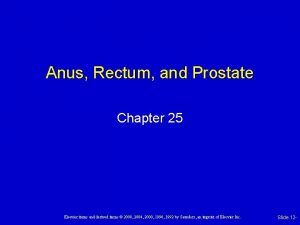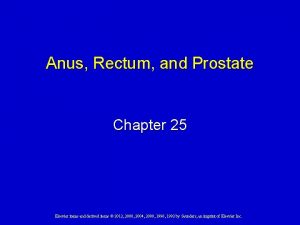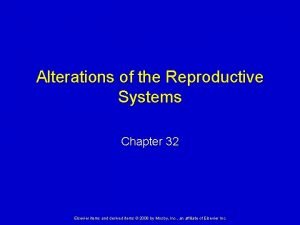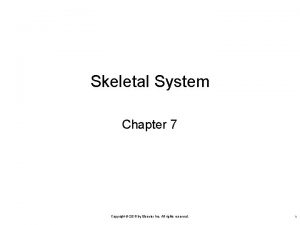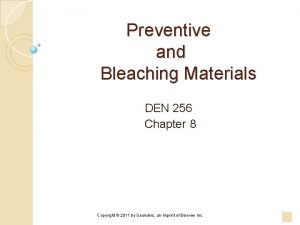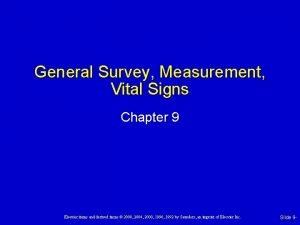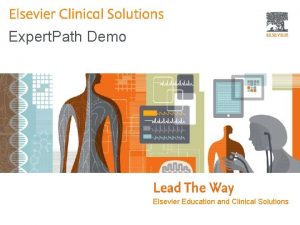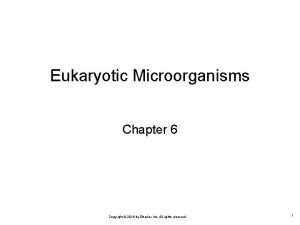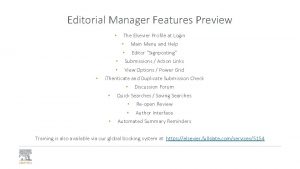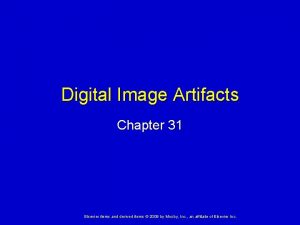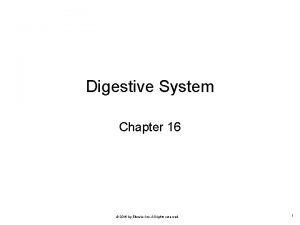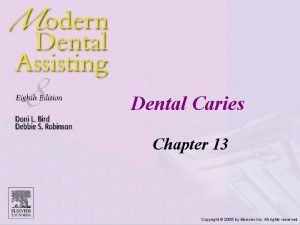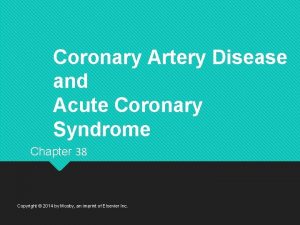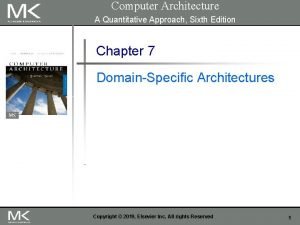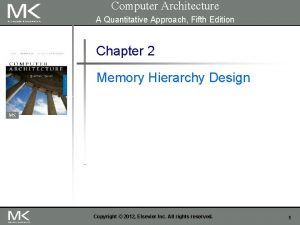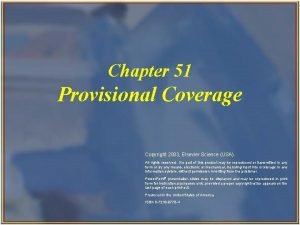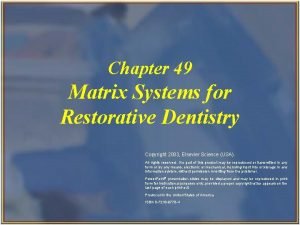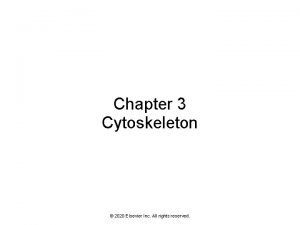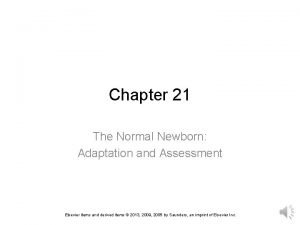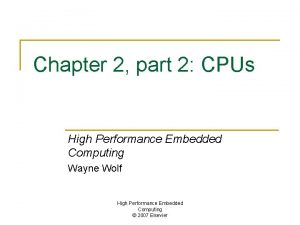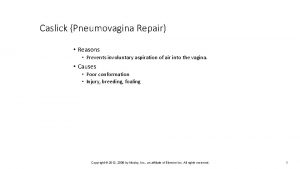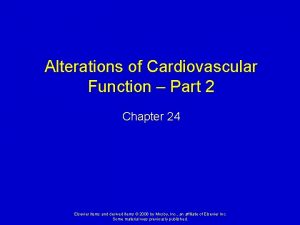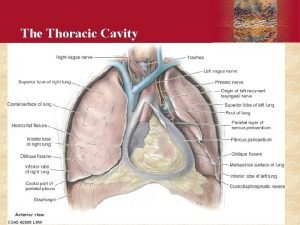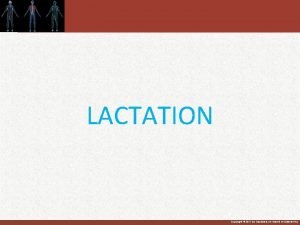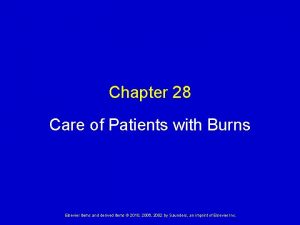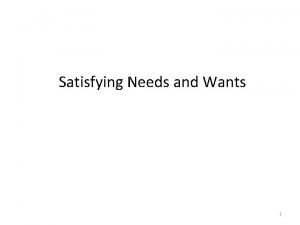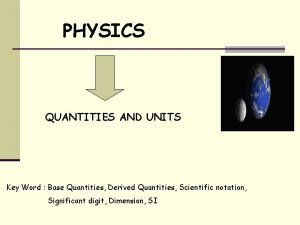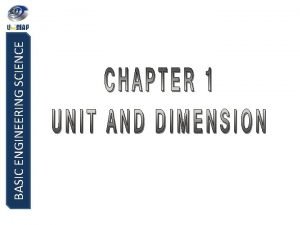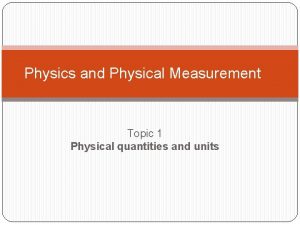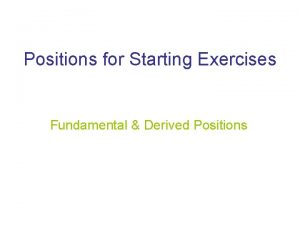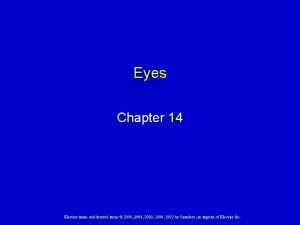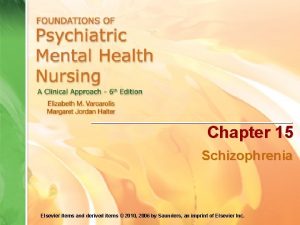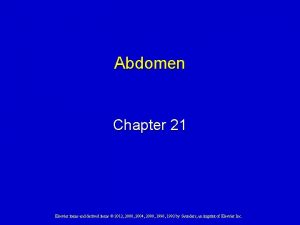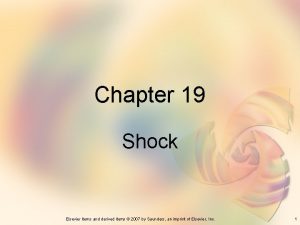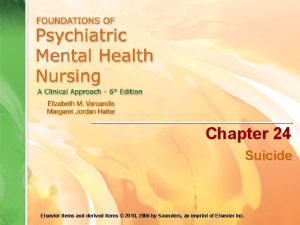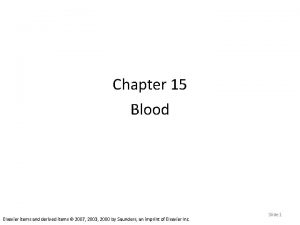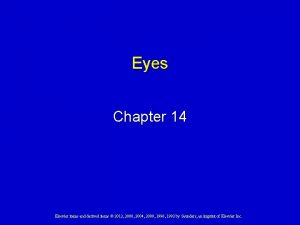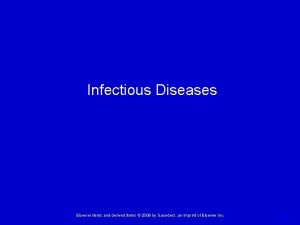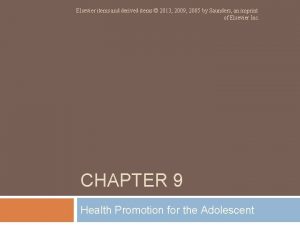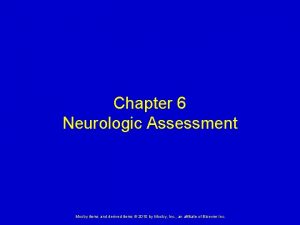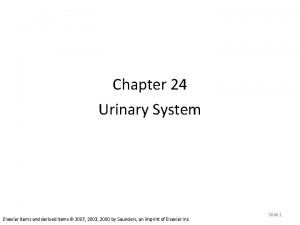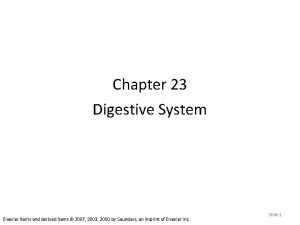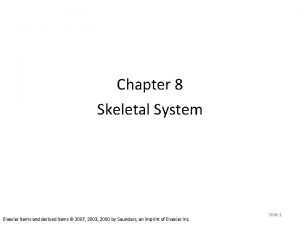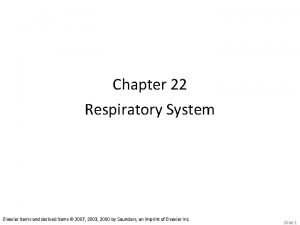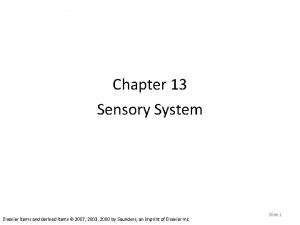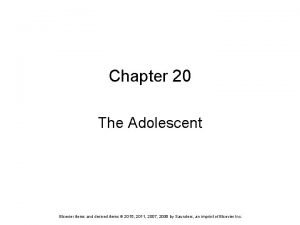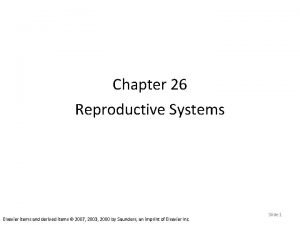Neurologic System Chapter 23 Elsevier items and derived


















































































































- Slides: 114

Neurologic System Chapter 23 Elsevier items and derived items © 2012, 2008, 2004, 2000, 1996, 1992 by Saunders, an imprint of Elsevier Inc.

Chapter 23: Neurologic System Structure and Function Nervous system divided into two parts: Central nervous system (CNS), which includes brain and spinal cord Ø Peripheral nervous system (PNS), which includes all nerve fibers outside brain and spinal cord • Includes 12 pairs of cranial nerves, 31 pairs of spinal Ø nerves, and all their branches • Carries sensory (afferent) messages to CNS from sensory receptors • Motor (efferent) messages from CNS to muscles and glands, as well as autonomic messages that govern internal organs and blood vessels Elsevier items and derived items © 2012, 2008, 2004, 2000, 1996, 1992 by Saunders, an imprint of Elsevier Inc. Slide 23 -2

Chapter 23: Neurologic System Central Nervous System [PRODUCTION NOTE: Please insert Figure 23 -2 (from Jarvis Physical Examination and Health Assessment, 5 e, ISBN: 978 -1 -4160 -3243 -4)] © Pat Thomas, 2006. Elsevier items and derived items © 2012, 2008, 2004, 2000, 1996, 1992 by Saunders, an imprint of Elsevier Inc. Slide 23 -3

Chapter 23: Neurologic System Structure and Function: Central Nervous System (CNS) Cerebral cortex is cerebrum’s outer layer of nerve cells Ø Cerebral cortex is center of functions governing thought, memory, reasoning, sensation, and voluntary movement • Each half of cerebrum is hemisphere • Each hemisphere divided into four lobes: frontal, parietal, Ø temporal, and occipital Elsevier items and derived items © 2012, 2008, 2004, 2000, 1996, 1992 by Saunders, an imprint of Elsevier Inc. Slide 23 -4

Chapter 23: Neurologic System Structure and Function: Central Nervous System (CNS) (cont. ) Cerebral cortex (cont. ) Ø Lobes have areas that mediate specific functions: • Frontal lobe concerned with personality, behavior, emotions, and intellectual function Precentral gyrus of frontal lobe initiates voluntary movement • Parietal lobe’s postcentral gyrus is primary center for sensation • Occipital lobe is primary visual receptor center • Temporal lobe behind ear, has primary auditory reception center, taste, and smell Elsevier items and derived items © 2012, 2008, 2004, 2000, 1996, 1992 by Saunders, an imprint of Elsevier Inc. Slide 23 -5

Chapter 23: Neurologic System Structure and Function: Central Nervous System (CNS) (cont. ) Cerebral cortex (cont. ) Ø Lobes have areas that mediate specific functions (cont. ): • Wernicke’s area in temporal lobe associated with language comprehension When damaged in the person’s dominant hemisphere, receptive aphasia results; person hears sound, but it has no meaning, like hearing a foreign language • Broca’s area in frontal lobe mediates motor speech When injured in dominant hemisphere, expressive aphasia results; person cannot talk; person can understand language and knows what they want to say, but can produce only garbled sound Elsevier items and derived items © 2012, 2008, 2004, 2000, 1996, 1992 by Saunders, an imprint of Elsevier Inc. Slide 23 -6

Chapter 23: Neurologic System Structure and Function: Central Nervous System (CNS) (cont. ) Cerebral cortex (cont. ) Damage to specific cortical areas produces a corresponding loss of function: • Motor weakness • Paralysis • Loss of sensation • Impaired ability to understand process language Ø Damage occurs when highly specialized neurologic cells are deprived of blood supply, such as when a cerebral artery becomes occluded Ø Elsevier items and derived items © 2012, 2008, 2004, 2000, 1996, 1992 by Saunders, an imprint of Elsevier Inc. Slide 23 -7

Chapter 23: Neurologic System Cerebral Cortex Elsevier items and derived items © 2012, 2008, 2004, 2000, 1996, 1992 by Saunders, an imprint of Elsevier Inc. Slide 23 -8

Chapter 23: Neurologic System Structure and Function: Central Nervous System (CNS) (cont. ) Basal ganglia Ø Large bands of gray matter in two cerebral hemispheres that form subcortical associated motor system (extrapyramidal system) • Initiate and coordinate movement and control automatic associated movements of body Thalamus Ø Main relay station where sensory pathways of spinal cord, cerebellum, and brain stem form synapses Elsevier items and derived items © 2012, 2008, 2004, 2000, 1996, 1992 by Saunders, an imprint of Elsevier Inc. Slide 23 -9

Chapter 23: Neurologic System Structure and Function: Central Nervous System (CNS) (cont. ) Hypothalamus Ø Major respiratory center with many basic functions, such as appetite, sex drive, temperature, heart rate, blood pressure, sleep, anterior and posterior pituitary gland regulation, and coordination of autonomic nervous system, stress response, and emotional status Elsevier items and derived items © 2012, 2008, 2004, 2000, 1996, 1992 by Saunders, an imprint of Elsevier Inc. Slide 23 -10

Chapter 23: Neurologic System Structure and Function: Central Nervous System (CNS) (cont. ) Cerebellum Coiled structure located under occipital lobe concerned with coordination of voluntary movements, equilibrium, and muscle tone Ø Does not initiate, but coordinates and smoothes movements • Coordinates many different muscles needed in playing Ø piano, swimming, or juggling • Adjusts and corrects voluntary movements, but operates entirely below conscious level Elsevier items and derived items © 2012, 2008, 2004, 2000, 1996, 1992 by Saunders, an imprint of Elsevier Inc. Slide 23 -11

Chapter 23: Neurologic System Structure and Function: Central Nervous System (CNS) (cont. ) Brain Stem Ø Central core of brain consists of nerve fibers: • Cranial nerve (CN) III through XII originate from nuclei in • • • brain stem Midbrain: most anterior part of brain stem with tubular structure of spinal cord; merges into thalamus and hypothalamus; contains many motor neurons and tracts Pons: enlarged area containing ascending sensory and descending motor tracts Medulla: continuation of spinal cord in brain; contains all fiber tracts connecting brain and spinal cord Has vital autonomic centers (respiration, heart, gastrointestinal function); nuclei for CN VIII through XII Pyramidal decussation (crossing of motor fibers) Elsevier items and derived items © 2012, 2008, 2004, 2000, 1996, 1992 by Saunders, an imprint of Elsevier Inc. Slide 23 -12

Chapter 23: Neurologic System Structure and Function: Central Nervous System (CNS) (cont. ) Spinal Cord Long cylindrical structure of nervous tissue that occupies upper two thirds of vertebral canal from medulla to lumbar vertebrae L 1 to L 2 Ø Main highway for ascending and descending fiber tracts that connect the brain to spinal nerves, and it mediates reflexes Ø Nerve cell bodies, or gray matter, arranged in butterfly shape with anterior and posterior “horns” Ø Elsevier items and derived items © 2012, 2008, 2004, 2000, 1996, 1992 by Saunders, an imprint of Elsevier Inc. Slide 23 -13

Chapter 23: Neurologic System Structure and Function: Central Nervous System (CNS) (cont. ) Pathways of CNS Ø Crossed representation is notable feature of nerve tracts • Left cerebral cortex receives sensory information from and controls motor function to right side of the body • Right cerebral cortex likewise interacts with left side of body Ø Knowledge of where fibers cross midline will help interpret clinical findings Elsevier items and derived items © 2012, 2008, 2004, 2000, 1996, 1992 by Saunders, an imprint of Elsevier Inc. Slide 23 -14

Chapter 23: Neurologic System Structure and Function: Central Nervous System (CNS) (cont. ) Sensory pathways Ø Millions of sensory receptors are embroidered into skin, mucous membranes, muscles, tendons, and viscera • Monitor conscious sensation, internal organ functions, body position, and reflexes • Sensation travels in afferent fibers in peripheral nerve, through posterior (dorsal) root, and into spinal cord Ø There, may take one of two routes: spinothalamic tract or posterior (dorsal) columns Elsevier items and derived items © 2012, 2008, 2004, 2000, 1996, 1992 by Saunders, an imprint of Elsevier Inc. Slide 23 -15

Chapter 23: Neurologic System Structure and Function: Central Nervous System (CNS) (cont. ) Sensory pathways (cont. ) Ø Spinothalamic tract • Contains sensory fibers that transmit sensations of pain, temperature, and crude or light touch Fibers enter dorsal root of spinal cord and synapse with a second sensory neuron At thalamus, fibers synapse with third sensory neuron, carrying message to sensory cortex for full interpretation Ø Posterior (dorsal) columns • These fibers conduct sensations of position, vibration, and finely localized touch Elsevier items and derived items © 2012, 2008, 2004, 2000, 1996, 1992 by Saunders, an imprint of Elsevier Inc. Slide 23 -16

Chapter 23: Neurologic System Structure and Function: Central Nervous System (CNS) (cont. ) Sensory pathways (cont. ) Sensory cortex arranged in corresponding “map” of body; pain in right hand perceived at specific spot on left cortex map Ø Some organs absent from brain map, such as heart, liver, or spleen; you know you have one, but have no “felt image” of it • Pain originating in these organs is referred, e. g. , pain in Ø heart referred to chest, shoulder, and left arm, neighbors in fetal development; pain originating in spleen felt on left shoulder Elsevier items and derived items © 2012, 2008, 2004, 2000, 1996, 1992 by Saunders, an imprint of Elsevier Inc. Slide 23 -17

Chapter 23: Neurologic System Sensory Pathways Elsevier items and derived items © 2012, 2008, 2004, 2000, 1996, 1992 by Saunders, an imprint of Elsevier Inc. Slide 23 -18

Chapter 23: Neurologic System Structure and Function: Central Nervous System (CNS) (cont. ) Motor pathways Ø Corticospinal or pyramidal tract fibers mediate voluntary movement, particularly very skilled, discrete, purposeful movements, such as writing • Motor nerve fibers travel to brain stem crossing to opposite, contralateral side, (pyramidal decussation) and then pass down in lateral column of spinal cord • Permits very skilled and purposeful movements • Arranged in pattern called somatotopic organization • Parts whose movements are relatively more important occupy proportionally more space on this brain map Elsevier items and derived items © 2012, 2008, 2004, 2000, 1996, 1992 by Saunders, an imprint of Elsevier Inc. Slide 23 -19

Chapter 23: Neurologic System Structure and Function: Central Nervous System (CNS) (cont. ) Motor pathways (cont. ) Ø Extrapyramidal tracts include motor nerve fibers originating in motor cortex, basal ganglia, brain stem, and spinal cord outside pyramidal tract • Subcortical motor fibers maintain muscle tone and control body movements, especially gross automatic movements, such as walking • Cerebellar system coordinates movement, maintains equilibrium and posture; receives information on position of muscles and joints, body’s equilibrium, and kind of motor messages sent from cortex to muscles Elsevier items and derived items © 2012, 2008, 2004, 2000, 1996, 1992 by Saunders, an imprint of Elsevier Inc. Slide 23 -20

Chapter 23: Neurologic System Structure and Function: Central Nervous System (CNS) (cont. ) Upper and lower motor neurons Ø Upper neurons • Complex of descending motor fibers that can influence or modify lower motor neurons • Located completely within CNS; convey impulses from motor areas of cerebral cortex to lower motor neurons • Examples of upper motor neuron diseases are cerebrovascular accident, cerebral palsy, and multiple sclerosis Elsevier items and derived items © 2012, 2008, 2004, 2000, 1996, 1992 by Saunders, an imprint of Elsevier Inc. Slide 23 -21

Chapter 23: Neurologic System Structure and Function: Central Nervous System (CNS) (cont. ) Upper and lower motor neurons (cont. ) Ø Lower motor neurons • Final common pathway, providing final contact with muscle • Located in anterior gray column of spinal cord, but nerve fibers extend to muscle • Movement must be translated into action by lower motor neuron fibers Examples of lower motor neurons are cranial nerves and spinal nerves of peripheral nervous system Examples of lower motor neuron diseases are spinal cord lesions, poliomyelitis, and amyotrophic lateral sclerosis Elsevier items and derived items © 2012, 2008, 2004, 2000, 1996, 1992 by Saunders, an imprint of Elsevier Inc. Slide 23 -22

Chapter 23: Neurologic System Motor Pathways Elsevier items and derived items © 2012, 2008, 2004, 2000, 1996, 1992 by Saunders, an imprint of Elsevier Inc. Slide 23 -23

Chapter 23: Neurologic System Structure and Function: Peripheral Nervous System Reflex Arc Ø Reflexes: basic defense mechanisms of nervous system • Involuntary; below level of conscious control permitting quick reaction to potentially painful or damaging situations Ø Four types of reflexes: • Deep tendon reflexes (myotatic), e. g. , knee jerk • Superficial, e. g. , corneal reflex, abdominal reflex • Visceral, e. g. , pupillary response to light • Pathologic (abnormal), e. g. , Babinski’s reflex or extensor plantar reflex Elsevier items and derived items © 2012, 2008, 2004, 2000, 1996, 1992 by Saunders, an imprint of Elsevier Inc. Slide 23 -24

Chapter 23: Neurologic System Reflex Arc Elsevier items and derived items © 2012, 2008, 2004, 2000, 1996, 1992 by Saunders, an imprint of Elsevier Inc. Slide 23 -25

Chapter 23: Neurologic System Structure and Function: Peripheral Nervous System (cont. ) Cranial nerves Enter and exit brain rather than spinal cord Ø CN I and II extend from cerebrum; cranial nerves III to XII extend from lower diencephalon and brain stem Ø 12 pairs of cranial nerves supply primarily head and neck, except vagus nerve, which travels to heart, respiratory muscles, stomach, and gallbladder Ø Elsevier items and derived items © 2012, 2008, 2004, 2000, 1996, 1992 by Saunders, an imprint of Elsevier Inc. Slide 23 -26

Chapter 23: Neurologic System Structure and Function: Peripheral Nervous System (cont. ) Spinal nerves 31 pairs of spinal nerves arise from length of spinal cord and supply rest of body Ø Named for region of spine from which they exit: 8 cervical, 12 thoracic, 5 lumbar, 5 sacral, and 1 coccygeal Ø “Mixed” nerves, they contain both sensory and motor fibers Ø Each innervates particular segment of body Ø Dermal segmentation is cutaneous distribution of various spinal nerves Ø Elsevier items and derived items © 2012, 2008, 2004, 2000, 1996, 1992 by Saunders, an imprint of Elsevier Inc. Slide 23 -27

Chapter 23: Neurologic System Structure and Function: Peripheral Nervous System (cont. ) Spinal nerves (cont. ) Ø Dermatome • Circumscribed skin area supplied mainly from one spinal cord segment through particular nerve • Dermatomes overlap; if one nerve is severed, most of sensations are transmitted by one above and one below Ø Useful landmark dermatomes • Thumb, middle finger, fifth finger are C 6, C 7, and C 8; Axilla at T 1; Nipple at T 4; Umbilicus at T 10; Groin in region of L 1; Knee at L 4 Elsevier items and derived items © 2012, 2008, 2004, 2000, 1996, 1992 by Saunders, an imprint of Elsevier Inc. Slide 23 -28

Chapter 23: Neurologic System Structure and Function: Peripheral Nervous System (cont. ) Autonomic nervous system Peripheral nervous system composed of cranial nerves and spinal nerves Ø Carry fibers divided functionally into two parts: • Somatic fibers innervate skeletal (voluntary) muscles • Autonomic fibers innervate smooth (involuntary) muscles, Ø cardiac muscle, and glands Ø Autonomic system mediates unconscious activity Elsevier items and derived items © 2012, 2008, 2004, 2000, 1996, 1992 by Saunders, an imprint of Elsevier Inc. Slide 23 -29

Chapter 23: Neurologic System Structure and Function: Developmental Competence Infants Ø Neurologic system not completely developed at birth • Movement directed primarily by primitive reflexes • Persistence of primitive reflexes is an indication of CNS dysfunction • Sensory and motor development proceed with gradual acquisition of myelin needed to conduct most impulses • As myelinization develops, infant able to localize stimulus more precisely and make more accurate motor response Elsevier items and derived items © 2012, 2008, 2004, 2000, 1996, 1992 by Saunders, an imprint of Elsevier Inc. Slide 23 -30

Chapter 23: Neurologic System Structure and Function: Developmental Competence (cont. ) Aging adult Ø Atrophy with steady loss of neuron structure in brain and spinal cord • Causes loss of weight and volume with thinning of cerebral cortex, reduced subcortical brain structures, and expansion of the ventricles • People over 65 show signs that, in younger adult, would be considered abnormal such as general loss of muscle bulk, loss of muscle tone in face, neck, and around spine, decreased muscle strength, impaired fine coordination and agility, loss of vibratory sense at ankle, decreased or absent Achilles reflex, pupillary miosis, irregular pupil shape, and decreased pupillary reflexes Elsevier items and derived items © 2012, 2008, 2004, 2000, 1996, 1992 by Saunders, an imprint of Elsevier Inc. Slide 23 -31

Chapter 23: Neurologic System Structure and Function: Developmental Competence (cont. ) Aging adult (cont. ) Ø Atrophy with steady loss of neurons in brain and spinal cord (cont. ) • Velocity of nerve conduction decreases making reaction time slower in some older persons • Increased delay at synapse results in diminished sensation of touch, pain, taste, and smell • Motor system may show general slowing down of movement; muscle strength and agility decrease • Progressive decrease in cerebral blood flow and oxygen consumption may cause dizziness and loss of balance Elsevier items and derived items © 2012, 2008, 2004, 2000, 1996, 1992 by Saunders, an imprint of Elsevier Inc. Slide 23 -32

Chapter 23: Neurologic System Structure and Function: Cultural Competence African Americans More likely than whites to have high blood pressure Ø Tend to have strokes earlier in life and with more severe results than whites Ø Have almost twice risk of first stroke compared with whites Ø Elsevier items and derived items © 2012, 2008, 2004, 2000, 1996, 1992 by Saunders, an imprint of Elsevier Inc. Slide 23 -33

Chapter 23: Neurologic System Structure and Function: Cultural Competence (cont. ) American Indians Ø Ages 65 to 74, annual rates per 1000 population of new and recurrent strokes are 6. 1 for men and 6. 6 for women Mexican Americans Ø Age 20 and older, 2. 6% of men and 1. 8% of women have had stroke Elsevier items and derived items © 2012, 2008, 2004, 2000, 1996, 1992 by Saunders, an imprint of Elsevier Inc. Slide 23 -34

Chapter 23: Neurologic System Subjective Data Headache Have you had any unusually frequent or severe headaches? When did this start? How often does it occur? Ø Where do you feel headaches? Do headaches seem to be associated with anything? Ø Head injury Have you ever had any head injury? What part of head was injured? Describe. Ø Did you have loss of consciousness? For how long? Ø Elsevier items and derived items © 2012, 2008, 2004, 2000, 1996, 1992 by Saunders, an imprint of Elsevier Inc. Slide 23 -35

Chapter 23: Neurologic System Subjective Data (cont. ) Dizziness; vertigo Do you ever feel a lightheaded, swimming sensation, like feeling faint? When have you noticed this? How often does it occur? Does it occur with activity or a change in position? Ø Do you ever feel a sensation called vertigo, a rotational spinning sensation? Do you feel as if the room spins, or do you feel you are spinning? Does it come on suddenly or gradually? Ø Elsevier items and derived items © 2012, 2008, 2004, 2000, 1996, 1992 by Saunders, an imprint of Elsevier Inc. Slide 23 -36

Chapter 23: Neurologic System Subjective Data (cont. ) Seizures Ø Ever had any convulsions? When did they start? How often do they occur? • When seizure starts, do you have warning sign? • Motor activity: Where in your body do seizures begin? Do seizures travel through your body? Do they occur on one side or both? • Do you have any associated signs, such as color change in face or lips, loss of consciousness, or incontinence? • Are there any precipitating factors? Does anything seem to bring on seizures, such as activity, discontinuing medication, fatigue, stress? Elsevier items and derived items © 2012, 2008, 2004, 2000, 1996, 1992 by Saunders, an imprint of Elsevier Inc. Slide 23 -37

Chapter 23: Neurologic System Subjective Data (cont. ) Seizures (cont. ) Postictal phase: After having a seizure, do you sleep? Do you have confusion, weakness, headache, or muscle ache? Are you on any medication? Ø Coping strategies: How have seizures affected daily life and your occupation? Ø Tremors Any shakes or tremors in hands or face? When did these start? Ø Do they seem to grow worse with anxiety, intention, or rest? Do they affect daily activities? Ø Elsevier items and derived items © 2012, 2008, 2004, 2000, 1996, 1992 by Saunders, an imprint of Elsevier Inc. Slide 23 -38

Chapter 23: Neurologic System Subjective Data (cont. ) Weakness Is this generalized or local? Ø Does weakness occur with particular movement? Ø Is it hard to get up out of a chair or reach for an object? Ø With distal or small muscle weakness, it is hard to open a jar, write, use scissors, or walk without tripping? Ø Elsevier items and derived items © 2012, 2008, 2004, 2000, 1996, 1992 by Saunders, an imprint of Elsevier Inc. Slide 23 -39

Chapter 23: Neurologic System Subjective Data (cont. ) Incoordination Ø Do you have any problem with balance when walking? Any falling? Which way? Do your legs seem to give way? Any clumsy movement? Numbness or tingling Ø Does it ever feel like pins and needles? When did this start? Where do you feel it? Does it occur with activity? Elsevier items and derived items © 2012, 2008, 2004, 2000, 1996, 1992 by Saunders, an imprint of Elsevier Inc. Slide 23 -40

Chapter 23: Neurologic System Subjective Data (cont. ) Difficulty swallowing Do you have difficulty swallowing solids or liquids? Ø Have you experienced excessive saliva or drooling? Ø Difficulty speaking Ø Do you have difficultly forming words or saying what you intend? When did you first notice this? How long did it last? Significant history Ø Do you have a history of stroke (cerebrovascular accident), spinal cord injury, meningitis or encephalitis, congenital defect, or alcoholism? Elsevier items and derived items © 2012, 2008, 2004, 2000, 1996, 1992 by Saunders, an imprint of Elsevier Inc. Slide 23 -41

Chapter 23: Neurologic System Subjective Data (cont. ) Environmental and occupational hazards? Are you exposed to insecticides, organic solvents, or lead? Ø Are you taking any medications now? Ø How much alcohol do you drink? Each week? Each day? Ø How about mood-altering drugs, such as marijuana, cocaine, barbiturates, and tranquilizers? Ø Elsevier items and derived items © 2012, 2008, 2004, 2000, 1996, 1992 by Saunders, an imprint of Elsevier Inc. Slide 23 -42

Chapter 23: Neurologic System Subjective Data (cont. ) Additional history for infants and children Did mother have any health problems during pregnancy, such as infections or illnesses, medications taken, toxemia, hypertension, alcohol or drug use, or diabetes? Ø Was infant premature or full term? What was the infant’s birth weight? Ø Was there any birth trauma? Did infant breathe immediately? • Were you told infant’s Apgar scores? • Were there any congenital defects? Ø Elsevier items and derived items © 2012, 2008, 2004, 2000, 1996, 1992 by Saunders, an imprint of Elsevier Inc. Slide 23 -43

Chapter 23: Neurologic System Subjective Data (cont. ) Additional history for infants and children (cont. ) Reflexes: What have you noticed about infant’s behavior? Do infant’s sucking and swallowing seem coordinated? Does infant turn head toward touch? Does infant startle with a loud noise? Does infant grasp your finger? Ø Does child seem to have problem with balance? Has there been any unexplained falling clumsy or unsteady gait, progressive muscular weakness, or problems going up or down stairs or getting up from lying position? Ø Elsevier items and derived items © 2012, 2008, 2004, 2000, 1996, 1992 by Saunders, an imprint of Elsevier Inc. Slide 23 -44

Chapter 23: Neurologic System Subjective Data (cont. ) Additional history for infants and children (cont. ) Has child had any seizures? Did it occur with high fever? Was there any loss of consciousness? How long? Ø Did motor or developmental milestones come at about right age? Does child seem to be growing normally? How does development compare to that of siblings or age-mates? Ø Has child had any environmental exposure to lead? Ø Is there any family history of seizure disorder, cerebral palsy, or muscular dystrophy? Ø Elsevier items and derived items © 2012, 2008, 2004, 2000, 1996, 1992 by Saunders, an imprint of Elsevier Inc. Slide 23 -45

Chapter 23: Neurologic System Subjective Data (cont. ) Additional history for aging adult Ø Any problem with dizziness? • Does it occur when you first sit or stand up, when you • • • move your head, get up and walk, or after eating? Does it occur with any medications? (For men) Do you ever get up at night and feel faint while standing to urinate? How does dizziness affect your daily activities? Are you able to drive safely and maneuver within your house safely? What safety modifications have you applied at home? Elsevier items and derived items © 2012, 2008, 2004, 2000, 1996, 1992 by Saunders, an imprint of Elsevier Inc. Slide 23 -46

Chapter 23: Neurologic System Subjective Data (cont. ) Additional history for aging adult (cont. ) Have you noticed a decrease in memory or a change in mental function? Have you felt any confusion? Does it come on suddenly or gradually? Ø Have you noticed any tremor in hands or face? Is it worse with anxiety, activity, or rest? Does it seem to be relieved with alcohol, activity, or rest? Does it interfere with daily or social activities? Ø Have you had any sudden vision change or fleeting blindness? Did this occur along with weakness? Did you have any loss of consciousness? Ø Elsevier items and derived items © 2012, 2008, 2004, 2000, 1996, 1992 by Saunders, an imprint of Elsevier Inc. Slide 23 -47

Chapter 23: Neurologic System Objective Data (cont. ) Preparation Perform screening neurologic examination on well persons with no significant findings from history Ø Perform complete neurologic examination on persons with neurologic concerns, e. g. , headache, weakness, loss of coordination, or who have shown signs of neurologic dysfunction Ø Perform neurologic recheck examination on persons with demonstrated neurologic deficits who require periodic assessments, e. g. , hospitalized persons or those in extended care Ø Elsevier items and derived items © 2012, 2008, 2004, 2000, 1996, 1992 by Saunders, an imprint of Elsevier Inc. Slide 23 -48

Chapter 23: Neurologic System Objective Data (cont. ) Preparation (cont. ) Ø Integrate steps of neurologic examination with examination of particular part of body • Test cranial nerves while assessing head and neck; test superficial abdominal reflexes while assessing abdomen • Record all neurologic data together as a functional unit • Use following sequence for complete neurologic examinatinon Mental status Cranial nerves Motor system Sensory system Reflexes Elsevier items and derived items © 2012, 2008, 2004, 2000, 1996, 1992 by Saunders, an imprint of Elsevier Inc. Slide 23 -49

Chapter 23: Neurologic System Objective Data (cont. ) Preparation (cont. ) Ø Equipment needed: • Penlight • Tongue blade • Cotton swab • Cotton ball • Tuning fork: 128 Hz or 256 Hz • Percussion hammer Elsevier items and derived items © 2012, 2008, 2004, 2000, 1996, 1992 by Saunders, an imprint of Elsevier Inc. Slide 23 -50

Chapter 23: Neurologic System Objective Data: Test Cranial Nerves Cranial nerves Ø Cranial nerve I: olfactory nerve (not tested routinely) • Test sense of smell in those who report loss of smell, head trauma, and abnormal mental status, and when presence of intracranial lesion suspected • With person’s eyes closed, occlude one nostril and present familiar aromatic substance, e. g. , coffee, orange, vanilla, soap, or peppermint • Normally, person can identify an odor on each side of nose; normally decreased with aging; any asymmetry in sense of smell is important Elsevier items and derived items © 2012, 2008, 2004, 2000, 1996, 1992 by Saunders, an imprint of Elsevier Inc. Slide 23 -51

Chapter 23: Neurologic System Objective Data: Test Cranial Nerves (cont. ) Cranial nerves (cont. ) Ø Cranial nerve II: optic nerve • Test visual acuity and visual fields by confrontation • Using ophthalmoscope, examine ocular fundus to determine color, size, and shape of optic disc Elsevier items and derived items © 2012, 2008, 2004, 2000, 1996, 1992 by Saunders, an imprint of Elsevier Inc. Slide 23 -52

Chapter 23: Neurologic System Objective Data: Test Cranial Nerves (cont. ) Cranial nerves (cont. ) Ø Cranial Nerves III, IV, and VI: oculomotor, trochlear, and abducens nerves • Palpebral fissures usually equal in width • Check pupils for size, regularity, equality, direct and consensual light reaction, and accommodation • Assess extraocular movements by cardinal positions of gaze • Nystagmus is back-and-forth oscillation of eyes Elsevier items and derived items © 2012, 2008, 2004, 2000, 1996, 1992 by Saunders, an imprint of Elsevier Inc. Slide 23 -53

Chapter 23: Neurologic System Objective Data: Test Cranial Nerves (cont. ) Cranial nerves (cont. ) Ø Cranial Nerves III, IV, and VI: oculomotor, trochlear, and abducens nerves (cont. ) • Assess nystagmus carefully, noting: Presence of nystagmus in one or both eyes Pendular movement (oscillations move equally left to right); or jerk (a quick phase in one direction, then a slow phase in other) Amplitude: degree of movement: fine, medium, or coarse Frequency: constant, or fades after a few beats Plane of movement: horizontal, vertical, rotary, or combination Elsevier items and derived items © 2012, 2008, 2004, 2000, 1996, 1992 by Saunders, an imprint of Elsevier Inc. Slide 23 -54

Chapter 23: Neurologic System Objective Data: Test Cranial Nerves (cont. ) Cranial nerves (cont. ) Ø Cranial nerve V: trigeminal nerve • Motor function: assess muscles of mastication by • • • palpating temporal and masseter muscles as person clenches teeth Muscles should feel equally strong on both sides; try to separate jaws by pushing down on chin; normally you cannot Sensory function: with person’s eyes closed, test light touch sensation by touching a cotton wisp to designated areas on person’s face: forehead, cheeks, and chin Tests all three divisions of CN V: ophthalmic, maxillary, and mandibular Elsevier items and derived items © 2012, 2008, 2004, 2000, 1996, 1992 by Saunders, an imprint of Elsevier Inc. Slide 23 -55

Chapter 23: Neurologic System Objective Data: Test Cranial Nerves (cont. ) Cranial nerves (cont. ) Ø Cranial nerve V: trigeminal nerve (cont. ) • Corneal reflex: omit test, unless person has abnormal facial sensation or abnormalities of facial movement • Remove any contact lenses; with person looking forward, bring wisp of cotton in from side (to minimize defensive blinking) and lightly touch cornea, not conjunctiva Normally, person will blink bilaterally Corneal reflex may be decreased or absent in those who have worn contact lenses • This procedure tests sensory afferent in cranial nerve V and motor efferent in cranial nerve VII (muscles that close eye) Elsevier items and derived items © 2012, 2008, 2004, 2000, 1996, 1992 by Saunders, an imprint of Elsevier Inc. Slide 23 -56

Chapter 23: Neurologic System Objective Data: Test Cranial Nerves (cont. ) Cranial nerves (cont. ) Ø Cranial nerve VII: facial nerve • Motor function: Note mobility and facial symmetry as person responds to requests to smile, frown, close eyes tightly (against your attempt to open them), lift eyebrows, show teeth Have person puff cheeks, then press puffed cheeks in, to see that air escapes equally from both sides • Sensory function: (not tested routinely) Test only when you suspect facial nerve injury When indicated, test sense of taste by applying cotton applicator covered with solution of sugar, salt, or lemon juice to tongue and ask person to identify taste Elsevier items and derived items © 2012, 2008, 2004, 2000, 1996, 1992 by Saunders, an imprint of Elsevier Inc. Slide 23 -57

Chapter 23: Neurologic System Objective Data: Test Cranial Nerves (cont. ) Cranial nerves (cont. ) Ø Cranial nerve VIII: acoustic nerve (Vestibulocochlear) • Test hearing acuity by ability to hear normal conversation and by whispered voice test Elsevier items and derived items © 2012, 2008, 2004, 2000, 1996, 1992 by Saunders, an imprint of Elsevier Inc. Slide 23 -58

Chapter 23: Neurologic System Objective Data: Test Cranial Nerves (cont. ) Cranial nerves (cont. ) Ø Cranial nerves IX and X: glossopharyngeal and vagus nerves • Motor function Depress tongue with tongue blade, and note pharyngeal movement as person says “ahhh” or yawns; uvula and soft palate should rise in midline, and tonsillar pillars should move medially Touch posterior pharyngeal wall with tongue blade, and note gag reflex; voice should sound smooth, not strained • Sensory function Cranial nerve IX does mediate taste on posterior one third of tongue, but technically too difficult to test Elsevier items and derived items © 2012, 2008, 2004, 2000, 1996, 1992 by Saunders, an imprint of Elsevier Inc. Slide 23 -59

Chapter 23: Neurologic System Objective Data: Test Cranial Nerves (cont. ) Cranial nerves (cont. ) Ø Cranial nerve XI: spinal accessory nerve • Examine sternomastoid and trapezius muscles for equal • • • size Check equal strength by asking person to rotate head against resistance applied to side of chin Ask person to shrug shoulders against resistance These movements should feel equally strong on both sides Elsevier items and derived items © 2012, 2008, 2004, 2000, 1996, 1992 by Saunders, an imprint of Elsevier Inc. Slide 23 -60

Chapter 23: Neurologic System Objective Data: Test Cranial Nerves (cont. ) Cranial nerves (cont. ) Ø Cranial nerve XII: hypoglossal nerve • Inspect tongue; no wasting or tremors should be present • Note forward thrust in midline as person protrudes tongue • Ask person to say “light, tight, dynamite, ” and note that lingual speech (sounds of letters l, t, d, n) is clear and distinct Elsevier items and derived items © 2012, 2008, 2004, 2000, 1996, 1992 by Saunders, an imprint of Elsevier Inc. Slide 23 -61

Chapter 23: Neurologic System Objective Data: Inspect and Palpate Motor System Muscles Ø Size: inspect all muscle groups for size • Compare right side with left; muscle groups should be within normal size limits for age and should be symmetric bilaterally • If muscles in extremities are asymmetric, measure in centimeters and record difference; difference of 1 cm or less is not significant • Note that it is difficult to assess muscle mass in very obese people Elsevier items and derived items © 2012, 2008, 2004, 2000, 1996, 1992 by Saunders, an imprint of Elsevier Inc. Slide 23 -62

Chapter 23: Neurologic System Objective Data: Inspect and Palpate Motor System (cont. ) Muscles (cont. ) Strength: test muscle groups of extremities, neck, and trunk Ø Tone: normal tension in relaxed muscles • Persuade person to relax completely, and move each Ø extremity smoothly through a full range of motion; normally, note mild, even resistance to movement Ø Involuntary movements • Normally none occur; if present, note location, frequency, rate, and amplitude; note if movements can be controlled at will Elsevier items and derived items © 2012, 2008, 2004, 2000, 1996, 1992 by Saunders, an imprint of Elsevier Inc. Slide 23 -63

Chapter 23: Neurologic System Objective Data: Inspect and Palpate Motor System (cont. ) Cerebellar function Ø Balance Tests • Gait: observe as person walks 10 to 20 feet, turns, and returns to starting point; normally person moves with a sense of freedom; gait is smooth, rhythmic, and effortless; opposing arm swing is coordinated; person turns smooth; step length about 15 inches from heel to heel • Ask person to walk straight line in heel-to-toe fashion; this decreases base of support and accentuates any problem with coordination; normally person can walk straight and stay balanced • You may also test for balance by asking person to walk on toes, then on heels for a few steps Elsevier items and derived items © 2012, 2008, 2004, 2000, 1996, 1992 by Saunders, an imprint of Elsevier Inc. Slide 23 -64

Chapter 23: Neurologic System Objective Data: Inspect and Palpate Motor System (cont. ) Cerebellar function (cont. ) Ø Romberg test: • Ask person to stand up with feet together and arms at sides; when in stable position, ask person to close eyes and to hold position for about 20 seconds Normally, person can maintain posture and balance even with visual orienting information blocked • Ask person to perform shallow knee bend or hop in place, first on one leg, then other Demonstrates normal position sense, muscle strength, and cerebellar function Some individuals cannot hop because of aging or obesity Elsevier items and derived items © 2012, 2008, 2004, 2000, 1996, 1992 by Saunders, an imprint of Elsevier Inc. Slide 23 -65

Chapter 23: Neurologic System Objective Data: Inspect and Palpate Motor System (cont. ) Coordination and skilled movements Ø Rapid Alternating Movements (RAM) • Ask person to pat knees with both hands, lift up, turn hands over, and pat knees with backs of hands; then ask person to do this faster Normally done with equal turning and quick rhythmic pace • Alternatively, ask person to touch thumb to each finger on same hand, starting with the index finger, then reverse direction Normally done quickly and accurately Elsevier items and derived items © 2012, 2008, 2004, 2000, 1996, 1992 by Saunders, an imprint of Elsevier Inc. Slide 23 -66

Chapter 23: Neurologic System Objective Data: Inspect and Palpate Motor System (cont. ) Coordination and skilled movements (cont. ) Ø Rapid Alternating Movements (RAM) • Finger-to-finger test: with eyes open, ask person to use index finger to touch your finger, then their own nose; then move your finger to continue test Person’s movement should be smooth and accurate • Finger-to-nose test: ask person to close eyes and stretch out arms and touch tip of their nose with each index finger, alternating hands and increasing speed Normally this is done with accurate and smooth movement • Heel-to-shin test: ask person in supine position to place heel on opposite knee and run it down shin to ankle Normally, person moves heel in straight line down shin Elsevier items and derived items © 2012, 2008, 2004, 2000, 1996, 1992 by Saunders, an imprint of Elsevier Inc. Slide 23 -67

Chapter 23: Neurologic System Objective Data: Assess Sensory System Ask person to identify various sensory stimuli in order to test intactness of peripheral nerve fibers, sensory tracts, and higher cortical discrimination Routine screening procedures include testing superficial pain, light touch, and vibration in few distal locations, and testing stereognosis Ø Complete testing of sensory system warranted in those with neurologic symptoms (e. g. , localized pain, numbness, and tingling) or if you discover abnormalities Ø Elsevier items and derived items © 2012, 2008, 2004, 2000, 1996, 1992 by Saunders, an imprint of Elsevier Inc. Slide 23 -68

Chapter 23: Neurologic System Objective Data: Assess Sensory System (cont. ) Compare sensations on symmetric parts of body When you find definite decrease in sensation, map it by systematic testing in that area Ø Proceed from point of decreased sensation toward sensitive area; ask person to tell you where sensation changes; you can map exact borders of deficient area; draw results on diagram Ø Person’s eyes should be closed during tests Ø Take time to explain what will be happening and exactly how you expect person to respond Ø Elsevier items and derived items © 2012, 2008, 2004, 2000, 1996, 1992 by Saunders, an imprint of Elsevier Inc. Slide 23 -69

Chapter 23: Neurologic System Objective Data: Assess Sensory System (cont. ) Spinothalamic tract Pain: tested by person’s ability to perceive pinprick Ø Temperature: test temperature sensation only when pain sensation is abnormal; otherwise, you may omit it because the fiber tracts are much the same. Ø Light touch: apply wisp of cotton to skin in random order of sites and at irregular intervals; include arms, forearms, hands, chest, thighs, and legs; ask person to say “now” or “yes” when touch is felt Ø Compare symmetric points Ø Elsevier items and derived items © 2012, 2008, 2004, 2000, 1996, 1992 by Saunders, an imprint of Elsevier Inc. Slide 23 -70

Chapter 23: Neurologic System Objective Data: Assess Sensory System (cont. ) Posterior column tract Ø Vibration: test person’s ability to feel vibrations of tuning fork over bony prominences • Compare right side with left side; if you find a deficit, note whether gradual or abrupt Ø Position (kinesthesia): test person’s ability to perceive passive movements of extremities Elsevier items and derived items © 2012, 2008, 2004, 2000, 1996, 1992 by Saunders, an imprint of Elsevier Inc. Slide 23 -71

Chapter 23: Neurologic System Objective Data: Assess Sensory System (cont. ) Posterior column tract (cont. ) Ø Tactile discrimination (fine touch): tests also measure discrimination ability of sensory cortex • Stereognosis. test person’s ability to recognize objects by • • feeling their forms, sizes, and weights Graphesthesia: ability to “read” a number by having it traced on skin Two-point discrimination: test ability to distinguish separation of two simultaneous pin points on skin Extinction: simultaneously touch both sides of body at same point; normally, both sensations are felt Point location: touch skin and withdraw stimulus promptly; ask person to put finger where you touched Elsevier items and derived items © 2012, 2008, 2004, 2000, 1996, 1992 by Saunders, an imprint of Elsevier Inc. Slide 23 -72

Chapter 23: Neurologic System Objective Data: Test the Reflexes Deep tendon reflexes (DTRs) Measurement of stretch reflexes reveals intactness of reflex arc at specific spinal levels and normal override on reflex of higher cortical levels Ø Limb should be relaxed and muscle partially stretched Ø Stimulate reflex by directing short, snappy blow of reflex hammer onto muscle’s insertion tendon Ø Compare right and left sides: responses should be equal Ø Elsevier items and derived items © 2012, 2008, 2004, 2000, 1996, 1992 by Saunders, an imprint of Elsevier Inc. Slide 23 -73

Chapter 23: Neurologic System Objective Data: Test the Reflexes (cont. ) Deep tendon reflexes (DTRs) (cont. ) Ø Reflex response graded on 4 -point scale • 4 = very brisk, hyperactive with clonus, indicative of disease 3 = brisker than average, may indicate disease 2 = Average, normal 1 = diminished, low normal, or occurs with reinforcement 0 = no response • • Ø Subjective scale requires clinical practice; scale not completely reliable; a wide range of normal exists in reflex responses Elsevier items and derived items © 2012, 2008, 2004, 2000, 1996, 1992 by Saunders, an imprint of Elsevier Inc. Slide 23 -74

Chapter 23: Neurologic System Objective Data: Test the Reflexes (cont. ) Biceps reflex, C 5 to C 6 Ø Support the person’s forearm on yours; place your thumb on biceps tendon and strike a blow on your thumb • Normal response is contraction of biceps muscle and flexion of forearm Triceps reflex, C 7 to C 8 Ø Tell person to let arm “just go dead” as you strike triceps tendon directly just above the elbow • Normal response is extension of forearm Elsevier items and derived items © 2012, 2008, 2004, 2000, 1996, 1992 by Saunders, an imprint of Elsevier Inc. Slide 23 -75

Chapter 23: Neurologic System Objective Data: Test the Reflexes (cont. ) Brachioradialis reflex, C 5 to C 6 Ø Hold person’s thumbs to suspend forearms in relaxation and strike forearm directly, about 2 to 3 cm above radial styloid process • Normal response is flexion and supination of forearm Quadriceps reflex, L 2 to L 4 (“knee jerk”) Ø Let lower legs dangle freely to flex knee and stretch tendons; strike tendon directly just below patella • Normal response is extension of lower leg Elsevier items and derived items © 2012, 2008, 2004, 2000, 1996, 1992 by Saunders, an imprint of Elsevier Inc. Slide 23 -76

Chapter 23: Neurologic System Objective Data: Test the Reflexes (cont. ) Achilles reflex, L 5 to S 2 (“ankle jerk”) Ø Position person with knee flexed; hold foot in dorsiflexion and strike Achilles tendon directly • Normal response is foot plantar flexes against your hand Elsevier items and derived items © 2012, 2008, 2004, 2000, 1996, 1992 by Saunders, an imprint of Elsevier Inc. Slide 23 -77

Chapter 23: Neurologic System Objective Data: Test the Reflexes (cont. ) Clonus: test when reflexes hyperactive Ø Support lower leg in one hand with other hand, move foot up and down to relax muscle; then stretch muscle by briskly dorsiflexing foot; hold the stretch • Normal response: you feel no further movement • When clonus present, you will note rapid rhythmic contractions of calf muscle and movement of foot Elsevier items and derived items © 2012, 2008, 2004, 2000, 1996, 1992 by Saunders, an imprint of Elsevier Inc. Slide 23 -78

Chapter 23: Neurologic System Objective Data: Test the Reflexes (cont. ) Superficial (cutaneous) reflexes Sensory receptors in skin rather than in muscles; motor response is localized muscle contraction Ø Abdominal reflexes: upper: T 8 to T 10; lower: T 10 to T 12 • Person in supine position, knees slightly bent; use handle Ø end of reflex hammer to stroke skin • Move from each corner toward midline at both upper and lower abdominal levels • Normal response is ipsilateral contraction of abdominal muscle with observed deviation of umbilicus toward stroke Elsevier items and derived items © 2012, 2008, 2004, 2000, 1996, 1992 by Saunders, an imprint of Elsevier Inc. Slide 23 -79

Chapter 23: Neurologic System Objective Data: Test the Reflexes (cont. ) Superficial (cutaneous) reflexes (cont. ) Ø Cremasteric reflex, L 1 to L 2 (not routinely done) • On male, lightly stroke inner aspect of thigh with reflex hammer or tongue blade Ø Note elevation of ipsilateral testicle Plantar reflex, L 4 to S 2 • Position thigh with slight external rotation • With reflex hammer, draw a light stroke up lateral side of sole of foot and inward across ball of foot, like an upsidedown “J” Normal response is plantar flexion of toes and inversion and flexion of forefoot Elsevier items and derived items © 2012, 2008, 2004, 2000, 1996, 1992 by Saunders, an imprint of Elsevier Inc. Slide 23 -80

Chapter 23: Neurologic System Objective Data: Developmental Competence Infants Note if milestones normally expected for each month achieved, and more primitive reflexes eliminated from baby’s repertory when expected Ø Observations of infant’s spontaneous waking activity, responses to environmental stimuli, and social interaction with parents and others • By 2 months, baby smiles and recognizes parent’s face • Babbling occurs at 4 months, and one or two words Ø (mama, dada) used nonspecifically after 9 months Elsevier items and derived items © 2012, 2008, 2004, 2000, 1996, 1992 by Saunders, an imprint of Elsevier Inc. Slide 23 -81

Chapter 23: Neurologic System Objective Data: Developmental Competence (cont. ) Infants (cont. ) Ø Motor system • Observe spontaneous motor activity for smoothness and symmetry; smoothness of movement suggests proper cerebellar function, as does coordination involved in sucking and swallowing • Screen gross and fine motor coordination using Denver II test with its age-specific developmental milestones • Assess muscle tone by first observing resting posture Newborn favors flexed position; extremities symmetrically folded inward, hips slightly abducted, and fists tightly flexed Elsevier items and derived items © 2012, 2008, 2004, 2000, 1996, 1992 by Saunders, an imprint of Elsevier Inc. Slide 23 -82

Chapter 23: Neurologic System Objective Data: Developmental Competence (cont. ) Infants (cont. ) Ø Sensory system • You will perform very little sensory testing with infants • • and toddlers Newborn normally has hypoesthesia and requires strong stimulus to elicit a response Baby responds to pain by crying and a general reflex withdrawal of all limbs By 7 to 9 months, infant can localize stimulus and shows more specific signs of withdrawal Other sensory modalities not tested Elsevier items and derived items © 2012, 2008, 2004, 2000, 1996, 1992 by Saunders, an imprint of Elsevier Inc. Slide 23 -83

Chapter 23: Neurologic System Objective Data: Developmental Competence (cont. ) Infants (cont. ) Ø Reflexes • Infantile automatisms: reflexes that have predictable timetable of appearance and departure • For screening examination, just check rooting, grasp, tonic neck, and Moro reflexes • Rooting reflex: brush the infant’s cheek near mouth; note whether infant turns head toward that side and opens mouth Appears at birth; disappears at 3 to 4 months Elsevier items and derived items © 2012, 2008, 2004, 2000, 1996, 1992 by Saunders, an imprint of Elsevier Inc. Slide 23 -84

Chapter 23: Neurologic System Objective Data: Developmental Competence (cont. ) Infants (cont. ) Ø Reflexes (cont. ) • Palmar grasp: place baby’s head midline to ensure symmetric response; offer finger from baby’s ulnar side, away from thumb; note tight grasp of all baby’s fingers Present at birth; strongest at 1 to 2 months; disappears at 3 to 4 months • Plantar grasp: touch your thumb at ball of baby’s foot; note that toes curl down tightly Reflex present at birth; disappears at 8 to 10 months Elsevier items and derived items © 2012, 2008, 2004, 2000, 1996, 1992 by Saunders, an imprint of Elsevier Inc. Slide 23 -85

Chapter 23: Neurologic System Objective Data: Developmental Competence (cont. ) Infants (cont. ) Ø Reflexes (cont. ) • Tonic neck reflex: with baby supine, turn head to one side with chin over shoulder; note ipsilateral extension of arm and leg, and flexion of opposite arm and leg; the “fencing” position; turning head to opposite side, positions will reverse Appears by 2 to 3 months; decreases at 3 to 4 months; disappears by 4 to 6 months Elsevier items and derived items © 2012, 2008, 2004, 2000, 1996, 1992 by Saunders, an imprint of Elsevier Inc. Slide 23 -86

Chapter 23: Neurologic System Objective Data: Developmental Competence (cont. ) Infants (cont. ) Ø Reflexes (cont. ) • Moro reflex: startle infant by jarring crib, making a loud noise, or supporting head and back in semi-sitting position and quickly lowering infant to 30 degrees • Baby looks as if he or she is hugging a tree; symmetric abduction and extension of arms and legs, fanning fingers, and curling of index finger and thumb to C position; infant then brings in both arms and legs Present at birth; disappears at 1 to 4 months Elsevier items and derived items © 2012, 2008, 2004, 2000, 1996, 1992 by Saunders, an imprint of Elsevier Inc. Slide 23 -87

Chapter 23: Neurologic System Objective Data: Developmental Competence (cont. ) Preschool and school-age children Assess the child’s general behavior during play activities, reaction to parent, and cooperation with parent and with you Ø Much of motor assessment can be derived from watching child undress and manipulate buttons; indicates muscle strength, symmetry, joint range of motion, and fine motor skills Ø Use Denver II to screen gross and fine motor skills appropriate for child’s age Ø Elsevier items and derived items © 2012, 2008, 2004, 2000, 1996, 1992 by Saunders, an imprint of Elsevier Inc. Slide 23 -88

Chapter 23: Neurologic System Objective Data: Developmental Competence (cont. ) Preschool and school-age children (cont. ) Note child’s gait both walking and running; allow for normal wide-based gate of toddler and normal knock-kneed walk of preschooler Ø Normally, child can balance on one foot for about 5 seconds by 4 years, for 8 to 10 seconds at 5 years, and can hop at 4 years Ø Elsevier items and derived items © 2012, 2008, 2004, 2000, 1996, 1992 by Saunders, an imprint of Elsevier Inc. Slide 23 -89

Chapter 23: Neurologic System Objective Data: Developmental Competence (cont. ) Preschool and school-age children (cont. ) Ø Observe child as rising from supine position to sitting position, then to a stand; note muscles of neck, arms, legs, and abdomen • Normally child curls up midline to sit up, then pushes off with both hands against floor to stand Ø Assess fine coordination using finger-to-nose test • Demonstrate procedure first, then ask child to do test with the eyes open, then with eyes closed • Fine coordination not fully developed until child is 4 to 6 years; consider it normal if younger child can bring finger to within 2 to 5 cm of nose Elsevier items and derived items © 2012, 2008, 2004, 2000, 1996, 1992 by Saunders, an imprint of Elsevier Inc. Slide 23 -90

Chapter 23: Neurologic System Objective Data: Developmental Competence (cont. ) Preschool and school-age children (cont. ) Testing sensation very unreliable in toddlers and preschoolers Ø May test light touch by asking child to close eyes and point to spot where you touch Ø Elsevier items and derived items © 2012, 2008, 2004, 2000, 1996, 1992 by Saunders, an imprint of Elsevier Inc. Slide 23 -91

Chapter 23: Neurologic System Objective Data: Developmental Competence (cont. ) Preschool and school-age children (cont. ) When you need to test DTRs in young child, use your finger to percuss tendon Ø Use reflex hammer only with an older child; coax child to relax, or distract and percuss discreetly when child not paying attention Ø Knee jerk present at birth; then ankle jerk and brachial reflex appear; and triceps reflex present by 6 months Ø Elsevier items and derived items © 2012, 2008, 2004, 2000, 1996, 1992 by Saunders, an imprint of Elsevier Inc. Slide 23 -92

Chapter 23: Neurologic System Objective Data: Developmental Competence (cont. ) Aging adult Use same examination as with younger adults Ø Cranial nerves mediating taste and smell not usually tested, may show some decline in function Ø Decrease in muscle bulk most apparent in hand; dorsal hand muscles often look wasted, even with no apparent arthropathy; grip strength remains relatively good Ø Senile tremors occasionally occur; these benign tremors include an intention tremor of hands, head nodding, and tongue protrusion Ø Elsevier items and derived items © 2012, 2008, 2004, 2000, 1996, 1992 by Saunders, an imprint of Elsevier Inc. Slide 23 -93

Chapter 23: Neurologic System Objective Data: Developmental Competence (cont. ) Aging adult (cont. ) Dyskinesias: repetitive stereotyped movements in jaw, lips, or tongue may accompany senile tremors; no associated rigidity present Ø Gait may be slower and more deliberate than in younger person; may deviate from midline path Ø Rapid alternating movements, e. g. , pronating and supinating hands on thigh, may be difficult to perform Ø Elsevier items and derived items © 2012, 2008, 2004, 2000, 1996, 1992 by Saunders, an imprint of Elsevier Inc. Slide 23 -94

Chapter 23: Neurologic System Objective Data: Developmental Competence (cont. ) Aging adult (cont. ) After 65 years of age, loss of sensation of vibration at ankle malleolus common; loss of ankle jerk; tactile sensation may be impaired; may need stronger stimuli for light touch; and especially for pain Ø DTRs less brisk; those in upper extremities usually present, but ankle jerk commonly lost; knee jerks may be lost; because aging people find it difficult to relax limbs, always use reinforcement when eliciting DTRs Ø Elsevier items and derived items © 2012, 2008, 2004, 2000, 1996, 1992 by Saunders, an imprint of Elsevier Inc. Slide 23 -95

Chapter 23: Neurologic System Objective Data: Developmental Competence (cont. ) Aging adult (cont. ) Plantar reflex may be absent or difficult to interpret; often, you will not see a definite normal flexor response; still should consider definite extensor response abnormal Ø Superficial abdominal reflexes may be absent, probably because of stretching of musculature through pregnancy or obesity Ø Elsevier items and derived items © 2012, 2008, 2004, 2000, 1996, 1992 by Saunders, an imprint of Elsevier Inc. Slide 23 -96

Chapter 23: Neurologic System Objective Data: Developmental Competence (cont. ) Aging adult (cont. ) Ø Neurologic check • Some hospitalized persons have head trauma or a neurologic deficit due to systemic disease process Must be monitored closely for any improvement or deterioration in neurologic status and for any indication of increasing intracranial pressure • Signs of increasing intracranial pressure signal impending cerebral disaster and death and require early and prompt intervention Elsevier items and derived items © 2012, 2008, 2004, 2000, 1996, 1992 by Saunders, an imprint of Elsevier Inc. Slide 23 -97

Chapter 23: Neurologic System Objective Data: Developmental Competence (cont. ) Aging adult (cont. ) Ø Neurologic check (cont. ) • Use abbreviation of neurologic examination in following sequence: Level of consciousness Motor function Pupillary response Vital signs Elsevier items and derived items © 2012, 2008, 2004, 2000, 1996, 1992 by Saunders, an imprint of Elsevier Inc. Slide 23 -98

Chapter 23: Neurologic System Sample charting Elsevier items and derived items © 2012, 2008, 2004, 2000, 1996, 1992 by Saunders, an imprint of Elsevier Inc. Slide 23 -99

Chapter 23: Neurologic System Sample charting (cont. ) Elsevier items and derived items © 2012, 2008, 2004, 2000, 1996, 1992 by Saunders, an imprint of Elsevier Inc. Slide 23 -100

Chapter 23: Neurologic System Sample charting (cont. ) Elsevier items and derived items © 2012, 2008, 2004, 2000, 1996, 1992 by Saunders, an imprint of Elsevier Inc. Slide 23 -101

Chapter 23: Neurologic System Abnormal Findings Abnormalities in cranial nerves CN I, olfactory nerve • Anosmia Ø CN II, optic nerve • Defect or absent central vision • Defect in peripheral vision, hemianopsia • Absent light reflex • Papilledema • Optic atrophy • Retinal lesions Ø Elsevier items and derived items © 2012, 2008, 2004, 2000, 1996, 1992 by Saunders, an imprint of Elsevier Inc. Slide 23 -102

Chapter 23: Neurologic System Abnormal Findings (cont. ) Abnormalities in cranial nerves (cont. ) CN III, oculomotor nerve • Dilated pupil, ptosis, eye turns out and slightly down • Failure to move eye up, in, down • Absent light reflex Ø CN IV, trochlear nerve • Failure to turn eye down or out Ø CN V, trigeminal nerve • Absent touch and pain, paresthesias • No blink • Weakness of masseter or temporalis muscles Ø Elsevier items and derived items © 2012, 2008, 2004, 2000, 1996, 1992 by Saunders, an imprint of Elsevier Inc. Slide 23 -103

Chapter 23: Neurologic System Abnormal Findings (cont. ) Abnormalities in cranial nerves (cont. ) CN VI, abducens nerve • Failure to move laterally, diplopia on lateral gaze Ø CN VII, facial nerve • Absent or asymmetric facial movement • Loss of taste Ø CN VIII, acoustic nerve • Decrease or loss of hearing Ø CN IX, glossopharyngeal nerve Ø Elsevier items and derived items © 2012, 2008, 2004, 2000, 1996, 1992 by Saunders, an imprint of Elsevier Inc. Slide 23 -104

Chapter 23: Neurologic System Abnormal Findings (cont. ) Abnormalities in cranial nerves (cont. ) Ø CN X, vagus nerve • Uvula deviates to side • No gag reflex • Voice quality: Hoarse or brassy Nasal twang Husky • Dysphagia, fluids regurgitate through nose Ø CN XI, spinal accessory nerve • Absent movement of sternomastoid or trapezius muscles Elsevier items and derived items © 2012, 2008, 2004, 2000, 1996, 1992 by Saunders, an imprint of Elsevier Inc. Slide 23 -105

Chapter 23: Neurologic System Abnormal Findings (cont. ) Abnormalities in cranial nerves (cont. ) Ø CN XII, hypoglossal nerve • Tongue deviates to side • Slowed rate of tongue movement Abnormalities in muscle tone Flaccidity Ø Spasticity Ø Rigidity Ø Cogwheel rigidity Ø Elsevier items and derived items © 2012, 2008, 2004, 2000, 1996, 1992 by Saunders, an imprint of Elsevier Inc. Slide 23 -106

Chapter 23: Neurologic System Abnormal Findings (cont. ) ● Abnormalities in muscle movement: Paralysis Fasciculations Tic Myoclonus Seizure disorder Tremor Rest tremor Intention tremor Chorea Athetosis Elsevier items and derived items © 2012, 2008, 2004, 2000, 1996, 1992 by Saunders, an imprint of Elsevier Inc. Slide 23 -107

Chapter 23: Neurologic System Abnormal Findings (cont. ) Abnormal gaits: Spastic hemiparesis Ø Cerebellar ataxia Ø Parkinsonian (festinating) Ø Scissors Ø Steppage or footdrop Ø Waddling Ø Short leg Ø Elsevier items and derived items © 2012, 2008, 2004, 2000, 1996, 1992 by Saunders, an imprint of Elsevier Inc. Slide 23 -108

Chapter 23: Neurologic System Abnormal Findings (cont. ) Common patterns of motor system dysfunction: Cerebral palsy Ø Muscular dystrophy Ø Hemiplegia Ø Parkinsonism Ø Cerebellar Ø Paraplegia Ø Multiple sclerosis Ø Elsevier items and derived items © 2012, 2008, 2004, 2000, 1996, 1992 by Saunders, an imprint of Elsevier Inc. Slide 23 -109

Chapter 23: Neurologic System Abnormal Findings (cont. ) Common patterns of sensory loss Ø Peripheral neuropathy • Loss of sensation involves all modalities; loss most severe distally at feet and hands Ø Individual nerves or roots • Decrease or loss of all sensory modalities; corresponds to distribution of involved nerve Ø Spinal cord hemisection (Brown-Séquard syndrome) • Loss of pain and temperature, contralateral side, loss of vibration and position discrimination on ipsilateral side Elsevier items and derived items © 2012, 2008, 2004, 2000, 1996, 1992 by Saunders, an imprint of Elsevier Inc. Slide 23 -110

Chapter 23: Neurologic System Abnormal Findings (cont. ) Common patterns of sensory loss (cont. ) Ø Complete transection of spinal cord • Complete loss of all sensory modalities below level of lesion; associated with motor paralysis and loss of sphincter control Ø Thalamus • Loss of all sensory modalities on face, arm, and leg; contralateral to lesion Ø Cortex • Loss of discrimination on contralateral side; loss of graphesthesia, stereognosis, recognition of shapes and weights, finger finding Elsevier items and derived items © 2012, 2008, 2004, 2000, 1996, 1992 by Saunders, an imprint of Elsevier Inc. Slide 23 -111

Chapter 23: Neurologic System Abnormal Findings (cont. ) Abnormal postures Ø Decorticate rigidity • Upper extremities Flexion of arm, wrist, and fingers Adduction of arm: tight against thorax • Lower extremities • Extension, internal rotation, plantar flexion; indicates hemispheric lesion of cerebral cortex Elsevier items and derived items © 2012, 2008, 2004, 2000, 1996, 1992 by Saunders, an imprint of Elsevier Inc. Slide 23 -112

Chapter 23: Neurologic System Abnormal Findings (cont. ) Abnormal postures (cont. ) Ø Decerebrate rigidity • Upper extremities: stiffly extended, adducted, internal rotation, palms pronated • Lower extremities: stiffly extended, plantar flexion; teeth clenched; hyperextended back Ø More ominous than decorticate rigidity; indicates lesion in brain stem at midbrain or upper pons Flaccid quadriplegia • Complete loss of muscle tone and paralysis of all four extremities, indicating nonfunctional brain stem Elsevier items and derived items © 2012, 2008, 2004, 2000, 1996, 1992 by Saunders, an imprint of Elsevier Inc. Slide 23 -113

Chapter 23: Neurologic System Abnormal Findings (cont. ) Abnormal postures (cont. ) Ø Opisthotonos • Prolonged arching of back, with head and heels bent backward; indicates meningeal irritation Elsevier items and derived items © 2012, 2008, 2004, 2000, 1996, 1992 by Saunders, an imprint of Elsevier Inc. Slide 23 -114
 Mosby items and derived items
Mosby items and derived items Mosby items and derived items
Mosby items and derived items Mosby items and derived items
Mosby items and derived items Lliver
Lliver Mosby items and derived items
Mosby items and derived items Reproductive system
Reproductive system Mosby items and derived items
Mosby items and derived items Mosby items and derived items
Mosby items and derived items Mosby items and derived items
Mosby items and derived items Mosby items and derived items
Mosby items and derived items Absorptive atelectasis
Absorptive atelectasis Mosby items and derived items
Mosby items and derived items Mosby items and derived items
Mosby items and derived items Mosby items and derived items
Mosby items and derived items Altered cellular and tissue biology
Altered cellular and tissue biology Mosby items and derived items
Mosby items and derived items Mosby items and derived items
Mosby items and derived items Mosby items and derived items
Mosby items and derived items Mosby items and derived items
Mosby items and derived items Mosby items and derived items
Mosby items and derived items Mosby
Mosby Mosby items and derived items
Mosby items and derived items Mosby items and derived items
Mosby items and derived items Mosby items and derived items
Mosby items and derived items Mosby items and derived items
Mosby items and derived items Mosby items and derived items
Mosby items and derived items Mosby items and derived items
Mosby items and derived items Chapter 18 neurologic emergencies
Chapter 18 neurologic emergencies A 41 year old man presents with slow irregular breathing
A 41 year old man presents with slow irregular breathing Management of patients with neurologic trauma
Management of patients with neurologic trauma Management of patients with neurologic trauma
Management of patients with neurologic trauma Grounding separately derived systems
Grounding separately derived systems Non separately derived system grounding diagram
Non separately derived system grounding diagram Elsevier statdx
Elsevier statdx Reed elsevier ventures
Reed elsevier ventures Elsevier vs ieee
Elsevier vs ieee Elsevier clinical key
Elsevier clinical key Elsevier 2005
Elsevier 2005 Pancreatic calcification
Pancreatic calcification Elsevier
Elsevier General sense
General sense Elsevier
Elsevier Elsevier
Elsevier Elsevier ees
Elsevier ees Hs and ts
Hs and ts Picture for newborn
Picture for newborn Elsevier
Elsevier Elsevier
Elsevier Four quadrants of the abdomen
Four quadrants of the abdomen Http://journalfinder.elsevier.com
Http://journalfinder.elsevier.com Reaxys elsevier
Reaxys elsevier Elsevier
Elsevier Elsevier
Elsevier Precordium
Precordium Elsevier
Elsevier Elsevier ees
Elsevier ees Springer, elsevier, taylor & francis etc. are ______. *
Springer, elsevier, taylor & francis etc. are ______. * Reaxys elsevier
Reaxys elsevier Elsevier
Elsevier Ch 52 removable prosthodontics fill in the blank
Ch 52 removable prosthodontics fill in the blank Elsevier
Elsevier Elsevier
Elsevier Elsevier
Elsevier Elsevier
Elsevier Elsevier
Elsevier What is the function of anus
What is the function of anus Ovario
Ovario Chapter 7 4 skeletal system
Chapter 7 4 skeletal system Hivebench
Hivebench Saunders
Saunders Measurement elsevier
Measurement elsevier Expertpath
Expertpath Elsevier
Elsevier Elsevier profile
Elsevier profile Elsevier
Elsevier Elsevier
Elsevier Copyright
Copyright Elsevier
Elsevier Elsevier
Elsevier Elsevier
Elsevier Elsevier
Elsevier What is the purpose of provisional coverage?
What is the purpose of provisional coverage? Types of matrix bands in dentistry
Types of matrix bands in dentistry Elsevier
Elsevier Chapter 21 the normal newborn adaptation and assessment
Chapter 21 the normal newborn adaptation and assessment Elsevier
Elsevier Copyright
Copyright Elsevier
Elsevier Elsevier
Elsevier Elsevier
Elsevier Elsevier san diego
Elsevier san diego Elsevier
Elsevier Galactokinesis
Galactokinesis Burns elsevier
Burns elsevier Reset and reverse cleared items in sap
Reset and reverse cleared items in sap Needs and wants being satisfied
Needs and wants being satisfied Reset and reverse cleared items in sap
Reset and reverse cleared items in sap Kitchen layout principles
Kitchen layout principles Provides bulk and structure to baked goods
Provides bulk and structure to baked goods Service housekeeping request
Service housekeeping request Cutting and mixing food items
Cutting and mixing food items Pes and mass spec sample items
Pes and mass spec sample items Open closed and isolated system
Open closed and isolated system Circularory system
Circularory system Base and derived quantities
Base and derived quantities Lying fundamental position
Lying fundamental position Units, physical quantities, and vectors
Units, physical quantities, and vectors Basic engineering and science
Basic engineering and science Difference between fundamental and derived unit
Difference between fundamental and derived unit Starting and derived positions
Starting and derived positions Derived data type
Derived data type Binary choice items
Binary choice items Vaap content area cover sheet
Vaap content area cover sheet Use of semicolon to list items
Use of semicolon to list items Scif prohibited items list
Scif prohibited items list
